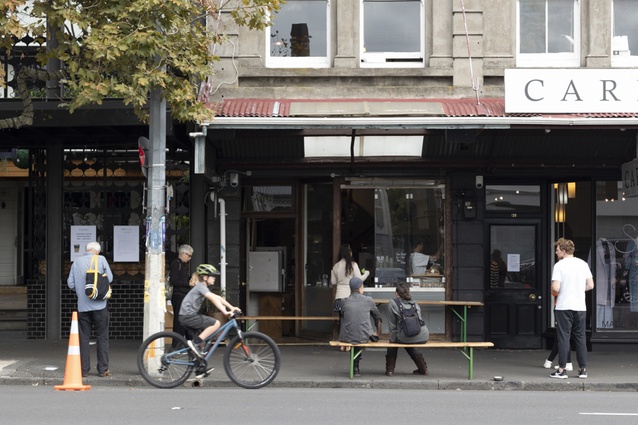Editorial: Chris Barton on the way forward
Of the many insights COVID-19 brings, the realisation that our economy is built as a house of cards is one of the more sobering. Two months into this global pandemic, what seemed so substantial and glittering – booming cities, 24x7 global travel, always-on connectivity – is tottering, reeling and falling down. Amidst the carnage, we see the house has a frighteningly vulnerable foundation.
At Architecture NZ, most of our advertising revenue disappeared in a puff of smoke. You tell us the magazine is worth fighting for. To survive, we ask you to subscribe. Thanks to those who have. We hope many will join us. Your messages of support are an ongoing documenting of reader power and our COVID resistance. You tell us why we must continue.
It begins with a 70-year legacy, the last 33 at AGM, that makes it part of our profession’s whakapapa. Architecture NZ is the publication of record for historians, says Julia Gatley. Patrick Clifford agrees: “Architecture NZ is the canon.” It provides the long view of who we are, and what we do, says Kathy Waghorn. John Sutherland, a reader since 1958: “There must be no demise. Architecture NZ is too important to us to let it fail.” Lynda Simmons says our magazines “literally lay current projects, concerns and thinking down, issue-by-issue, to create history.” Nick Officer reckons there’s a shelf in every architectural office in New Zealand with well-organised rows of Architecture NZ. A critical resource.
In a digital age, it seems people still want print. Pip Cheshire: “Architecture NZ is a tangible artefact in an ephemeral age.” Lisa Hinton: “People say print will die its natural death. But will we really let this happen to our cherished, glossy, heavy-stocked magazines that give us such a tactile experience of the architecture that inspires us?” Jon Rennie: “The weight, scale and haptic qualities of the printed page provide a place of respite from the day-to-day slog of the screen and its low-resolution.”
Graduate Abdallah Alayan: “While the threat of losing this treasured publication is most visibly due to a global pandemic, print media is often discussed as imminently expiring in the wake of younger generations’ preference for pixels.” Ask any architecture student, he says, and they will refute this. Roger Walker highlights an underrated advantage over the digital zeitgeist. “Unlike an iPad, it can be read while relaxing in a bath.”
Richard Naish argues the magazine plays a role in making architecture better: “We have an enviable collegial culture that is supportive but also critical in its collective pursuit of great architecture.” Architecture feeds on ideas, and ideas cannot thrive in a vacuum, says Pete Bossley. “Architecture NZ has given us a platform to see our buildings, discuss them, critique them.” Gordon Moller sees the magazine as capturing the creative collaboration between architect and client.
For Sharon Jansen, it reminds us “that quality design thinking is essential to our world.” Adam Mercer: “More than ever before, there is a need for architects to have a shopfront for our endeavours, that lasts longer than a one-shot-wonder on Instagram, Facebook or Houzz.” Raukura Turei says, “seeing the work of the younger practitioners in Aotearoa published is both incredibly inspiring and a meaningful way to celebrate their achievements while pushing against the status quo.”
It’s inspiring to consider the range of functions a magazine can fulfil – from the emotional to the esoteric to the educational. Jeremy Smith: “Architecture is many things; space, light, people, joy, but also critique. To suggest we no longer need this discourse is to suggest we’ve finished learning.” Daniel Brown: “The disappearance of Architecture NZ would be an irreparable loss to an entire generation of new young architects.”
Graduate Maito Akiyama argues the magazine, as a platform for student work, bridges the gap between academia and practice. To recent graduate Patrick Sherwood, the magazine represents a genealogy of New Zealand practice, an invaluable resource to learn about architecture and his place within it. Vanessa Coxhead: “I’ve thumbed through most issues, many from before I was not even a twinkle in my father’s eye, nor a blush on my mother’s cheek, as part of research projects charting the course of architecture in Aotearoa.”
The spirit of the community that the magazine both represents and builds is also evident. Malcolm Walker: “We are a profession, a good one. We can’t not have a magazine! Apart from dignity and prestige, we need a journal of record and we need collegial and professional critique, discourse and showing off.” Julie Stout: “Architecture NZ is what connects us architects as a collective, intellectually and emotionally, and displays ‘us’ to others.”
Divya Purushotham: “Architecture NZ has consistently provided a means for the industry to congregate, celebrate and critique.” The magazine is a meeting place, an open house, a broad church. Sarosh Mulla: “It isn’t just a magazine; it’s a collegial institution.” Kate Rogan and Eva Nash: “It gives us the space to share and debate issues that matter to us.”
As for future challenges, readers point to the vital role Architecture NZ has yet to play. Nicole Teh: “Its continuity stands incredibly important today in informing the imminent social and environmental imperatives of our time.” Chris Kelly: “Ongoing analysis and peer review will be essential as architects propose more relational, pared-back solutions that will support our population in a post-COVID economy.”
Many say the coronavirus pandemic will change everything. Change that might lead to an economy built with more stable foundations. Others worry the pandemic may become a force for dystopia rather than social progress. Architects can play a vital role in making a different path. With your help, I look forward to critiquing the way ahead in the next issue.
Read all of the messages of support here.
Subscribe to Architecture NZ here. Subscribe before 1 August 2020 and be entered to win a $6000 prize pack from Rocket Espresso New Zealand.










